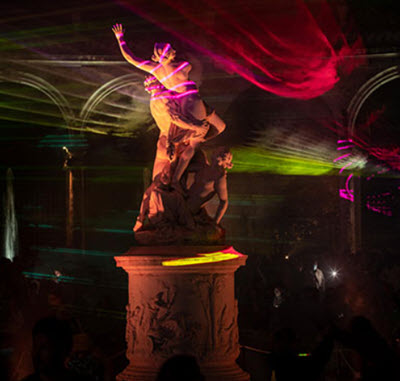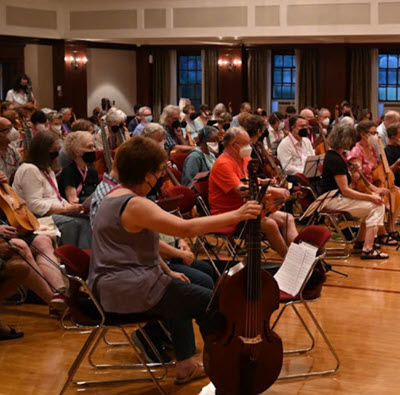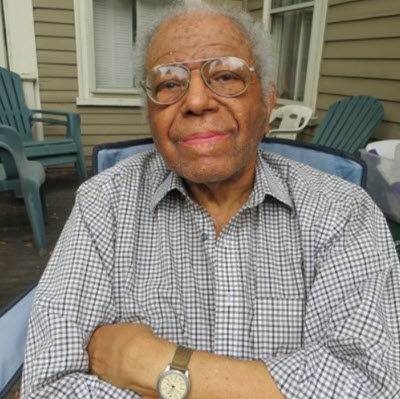by Anne E. Johnson
Published May 8, 2023
‘Some of the nuances of Baroque playing become simply obvious when you wear historical clothing’
Your instrument is an exact-as-possible copy of a 1589 original. You’ve tuned your A to the correct pitch for a particular year and region. You can absolutely nail 16 types of agréments.
But there’s another element of historically informed performance that might be worth considering.
What are you wearing?
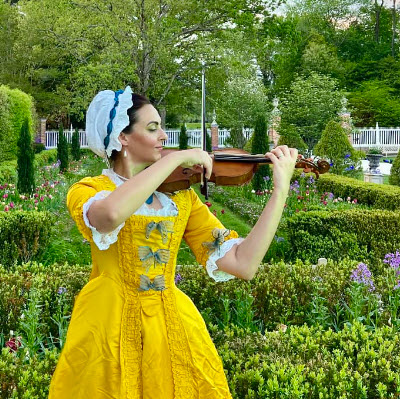
The clothes of the period, some argue, are part of a historically accurate performance. While opinions vary about what constitutes an acceptable and practical period outfit, advocates of historical costume in early music all have one thing in common: They believe the costume helps enrich the music’s context.
Baroque violinist Sophie Genevieve Lowe and Ryan Lowe, her husband and a Baroque cellist, have played duets at the Governor’s Palace at Colonial Williamsburg.
For these concerts, the Department of Historical Clothing at the Colonial Williamsburg Foundation provided all their clothing, from the cap to the buckled shoes, each item based accurately on styles from 1770-1776. The goal is that historical wardrobe matches what a historically informed musician would bring to the performance. Lowe says she had to take a course on how to put on the outfit in a historically accurate way: “The first time it took me well over an hour to figure it out! I found lacing the stays the most difficult part.”
But, she adds, “playing in period clothing has changed my perspective on what, in my case, an 18th-century performer would have to do. Some of the nuances of Baroque playing become simply obvious when you wear historical clothing. At the first performance we played, my husband said how much easier it was to hold the Baroque cello with his 18th-century stockings. I really appreciated my stays, which were designed to help women work, like a back brace. They were a wonderful support, and I found my back did not get tired even after a long performance. It was also remarkably comfortable with all the linen underneath the dress, which surprised me. The process to get into the clothing also became a serene mental preparation before the performance.”
On the opposite coast, John Smith IV is a longtime member of the Guild of St. George, a Los Angeles-area reenactment group focused on representing the nobility of Elizabethan England, which often includes music in their presentations. He sings in the Guild’s Early Music Ensemble, which he helped found in 1996. In his 2012 essay “In Search of Context” for the Southern California Early Music Society (SCEMS) newsletter, Smith claimed that, at a typical early-music concert, “the modern listener is not exposed to the full experience intended by the composer.”
Smith has been singing Elizabethan music since high school. He and his wife enjoyed attending the annual Renaissance Pleasure Faire in Irwin, Calif., and decided to try sewing some costumes to enhance the experience. Eventually they were invited to join the Guild of St. George. That was about 30 years ago, and they remain avid singers and period-clothing zealots.
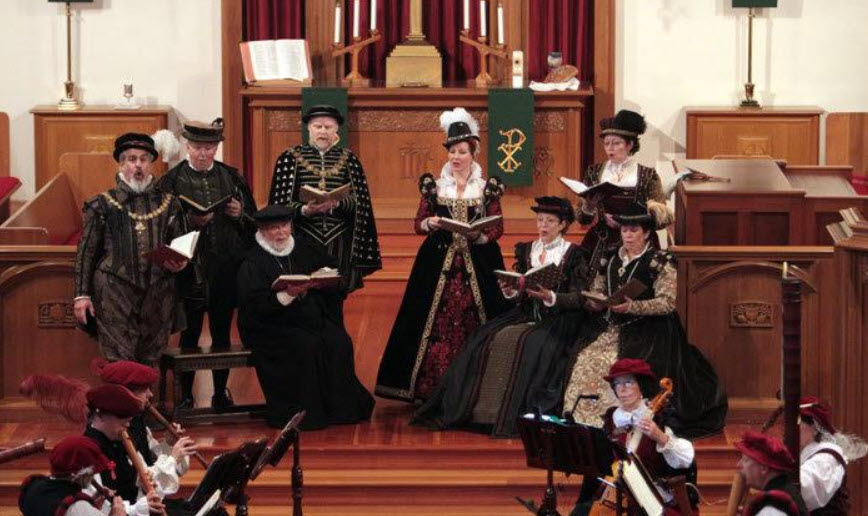
Smith also spearheaded an association between the Guild and a wind band called the Wessex Consort, directed by Bruce Teter, the current president of SCEMS. Teter plays musette, recorder, and other wind instruments. He also directs a medieval group called Los Goytx and a French Baroque group, Les Plaisirs Champetre, which uses original 18th-century instruments.
For Teter, period clothing helps establish historical legitimacy. “Wearing costumes in the French Baroque can make an atmosphere of recreating a performance that would have actually happened in a salon for a small audience in a small space.” He thinks this sparks listeners’ imaginations. “They are looking at this scene and then can imagine themselves placed back in history.”
There is also a Northern California branch of the Guild of St. George, just as enthusiastic about including music. Its wind band is the New Queen’s Ha’penny Consort. Recorder player Lisa Schultz, who lives in San Jose, has been a member for over 20 years. The group started out playing the Northern California Renaissance Faire, and still do.
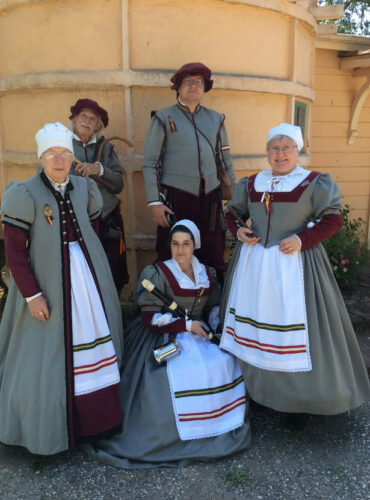
NQHC also plays at corporate parties and weddings and provides music in museums. They decide whether to wear costumes depending on the gig. Schultz explains, “There are certain types of events where the mood and the function is immersive and/or educational.” For those, they don period clothing.
“Putting on the costume makes me feel very playful,” she says. “I can take people into that world, with the costume and the accent and speaking in a way that makes them think that they have left their current troubles behind them.”
Teter also feels different, especially in his French Baroque costume. “I walk in an upright way with decorum when I greet people. The costume adds one extra little aspect that makes people feel like they’ve been taken back in time.”
Violinist Lowe believes there are really two approaches, and two different terms: historical clothing versus a costume in performance. “If one is to educate and replicate, then I believe it is imperative to have clothing that is as historical as possible,” she says. “Anything else is disingenuous and the audience can sense that in a performance. If the purpose is purely enjoyment, then there may be a place for a costume. (However, my preference in the latter case would be all black.)”
For her part, Schultz finds it is her attitude, not her music-making, that’s affected. “The costume does not make me feel different when I play.”
“It’s just like any other clothing that I would put on for performance,” agrees Helen-Jean Talbott, who directs the Baltimore-based recorder ensemble Consort Anon. “Part of that performance is the presentation to the audience, and part of that presentation is your appearance.”
Talbott, a skilled seamstress, recently co-wrote an in-depth article for the American Recorder Society’s website advising musicians on how to start using period costumes in their performances. She has been wearing costumes at Renaissance banquets and the Maryland Renaissance Festival since graduating from Peabody Conservatory with a Master’s degree in recorder performance. “When I’m wearing a costume,” she says, “I’m just as comfortable as in what I consider my concert dress.”
‘Putting on the costume makes me feel very playful. I can take people into that world, with the costume and the accent and speaking in a way that makes them think that they have left their current troubles behind them.’
Besides a costume’s potential to affect a musician’s bearing, it also might also affect repertoire. That was the case for Margaret Erin, viola da gambist and recorder player, who used to sew costumes for her Dayton-based ensemble, Wind in the Woods. The band’s decision to wear costumes inspired her to use many aspects of her music degree and interdisciplinary Master’s in the humanities.
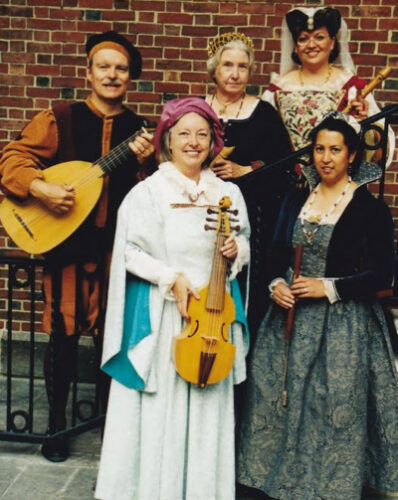
“My interest in history and literature spurred us on to create programs where there was some narration, giving context, putting in history,” she says. Erin wrote the scripts for these shows. One program, John Dowland and Friends, was narrated by the composer’s patron, Moritz, Landgrave of Hesse. The Queen’s Music was narrated by Blanche Perry, lifelong friend and lady-in-waiting to Queen Elizabeth I. “There was room for all kinds of creativity and imagination because we had costumes,” says Erin.
Many musicians use their period garb to enthrall children. Bruce Teter’s medieval group performs once a year at a middle school in Simi Valley. “We play for 400 seventh-graders, 20 at a time. They get medieval music right in their face. We wear costumes for that because kids need whatever they can get to keep their attention on you.”
Mix it and match it, like an Elizabethan
For musicians wondering how to procure costumes, one way to start is with sewing patterns, as Talbott does. Clever altering of pre-made costumes is one of Erin’s tricks. “For the men, I found a clown costume with baggy pants,” she says. She added drawstrings at the top and bottom and they bought their own ample shirts. Then she made tunics. For herself, she started with a full skirt and a blouse with puffy sleeves. “We ended up with bits and pieces, just like the Elizabethans did, so we could sort of mix and match.”
Schultz’s band also uses the mix-and-match approach on its costumes designed by the Guild of St. George. The Guild focuses on Elizabethan England, “But we got something that was a little peppier, a little festive. It’s in the Venetian style, not staid and English. You tend to do things to customize them. You can take the sleeves and adjust that; you can adjust different bits and pieces.”
The Guild decks out its bands in matching clothes, as Smith explains: “Instrumentalists were considered working class, so they wear a uniform that we call livery.” Smith prefers the term “clothing” to “costumes” because of the Guild’s dedication to authenticity. Although the pieces are not hand-sewn, they “are as close to reality as possible.” As for fabrics, “We try to make sure that it looks right.” Although Elizabethan nobility would have used silk velvet or silk satin, “silk velvet looks terrible,” says Smith. “It looks like cheap rayon. So we use upholstery-weight velvet for our clothes.”
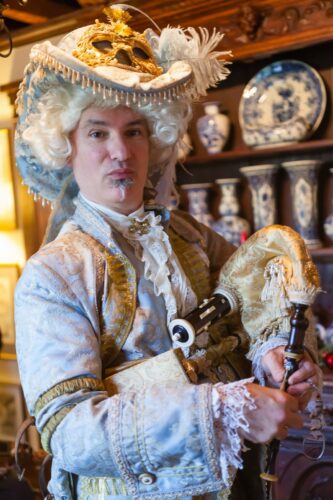
Only one of Teter’s bands plays with the Guild, but he uses period clothing for all of them. His duds for the French Baroque are especially spectacular. He bought a pre-made costume and had a designer add lace and trim. “I really dolled it up. And I’ve made parts of it myself—the hat and the feathers and a beautiful gold mask. I made buckles for the shoes with Swarovski crystals.
“My mother taught me how to sew on a sewing machine,” he admits.
For women’s costumes, one must face the topic of the dreaded corset. Schultz, who wears a full-length one under her Elizabethan dress, gives a mixed report: “It’s not necessarily the most comfortable thing to play a wind instrument in. But it’s actually very good for your breath control. It supports your posture.”
“We make sure the undergarments are absolutely accurate,” Smith says of the Guild. “An Elizabethan corset properly designed and made for you is more comfortable than a modern bra and underwear.” But he says his wife fine-tunes the tightness of her garment depending on whether she needs to sing.
“No corsets. Skip the corsets.” That’s Talbott’s view.
An important side note, not much talked about in the early-music field: The global climate has changed since the early-modern era, which in Northern Europe included the so-called Little Ice Age (c. 1560-1820). Just like it’s hard to recreate period-style Elizabethan or French rococo rooms in North America, it can be hard to find attire that’s historically appropriate for colder conditions while performing in significantly hotter weather.
The Maryland Renaissance Festival, for example, opens in late August. “It is beastly out,” says Talbott, “sometimes up to almost 100 degrees and humidity right about there, too.” No upholstery-grade material for her. “You’ve got to have fabric that’s going to breathe, and you need to be able to move.”
She also must be ready to play outside in rainy weather. Although her ensemble can usually find a sheltered area, “we have to walk from point A to point B in the rain. That means we have to have garments that can tolerate that.” Her solution? A special costume for wet days, a skirt and cape sewn from shower-curtain fabric. “When the rain hits it, it just goes right down.”
Custom design, heavy fabric, Swarovski crystals? That might strain many a freelancer musician’s bank account. But not everything has to be Guild grade, as Teter explains about his medieval band’s uniform. “Parts of it I make myself, parts of it I buy really cheap.” As the leader, he wears fancier garb, “but the rest of the band just dress up in simple medieval looking costumes.”
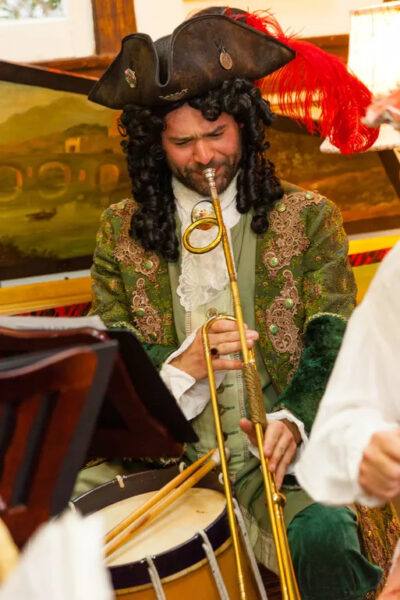
Smith describes his wife’s process, which takes an hour: chemise (full shirt), farthingale (hoop skirt), petticoat, corset, outer skirt with a decorative front panel, velvet overskirt over that, plus a bodice on her upper torso with full fitted sleeves and oversleeves.
Considering the trouble and expense involved, it’s natural to wonder why period costumes are worthwhile. For Smith, a big part of the joy is in the research. While he does not consider himself a historian, he relies on the scholarly work of others. “We are so fortunate that there are professionals who comb through all the data,” he says.
Smith is also adamant that focus on clothing does not mean the players don’t take the music seriously. Presentations by the Guild always focus on a specific time and place, and detailed musical research is part of the mix. Sometimes they get lucky and find out exactly what music was heard on a particular day. For example, the Queen visited the Earl of Hertford in 1592. “He commissioned works to be written for her visit. ‘Come again sweet nature’s treasure’ and ‘Elisa is the fairest Queen’ are two songs that we sing where the music itself was actually documented.”
Talbott also prioritizes the music, no matter what she’s wearing. “We try very hard to have the music organized and presented in the correct styles. I studied that music so much, and the more I learn about it, the better job I can do in terms of performing it.”
Schultz admits that her group wasn’t too interested in HIP at first. “But as time went on and musicianship got better, the bug caught them.” But she is still self-effacing about her credentials. “I don’t come at this as a music scholar,” she says. “I’m a performer.”
Is early music stuck in a 19th-century context?
That distinction is significant for Schultz. She does not wear costumes in a concert setting, which she thinks of as scholarly. “It has something to do with how seriously you take your music and how seriously you take the composer’s intention, and really what is your function there at the event. I come from a family of classical musicians who wouldn’t be caught dead in a costume! They would find that so denigrating. They would feel that it would compromise the integrity of their mission statement. And I see that.”
Smith believes that the concept of music’s function is period-specific. “If you’re looking at music as an art form, you’re looking at it in sort of a 19th-century context of, well, this is a pure art where you don’t even want the performers to be noticeable, hence you want all the performers to be in concert black.” He likens this to Beethoven or Mahler’s view that the composer is “talking directly to you as the audience, and the orchestra is just the mechanism by which [they] do that.”
He sees most professional early-music groups as presenting “music as music. In that environment, I don’t think it’s appropriate for them to be wearing costumes.”
‘If you are standing on a stage wearing a tuxedo, you’re wearing a costume every bit as much as I am if I’m wearing a doublet and hose.’
Explaining that the guitarist in his Baroque group refuses to wear costumes, Teter sounds understanding. “I think that among very professional musicians, there is a viewpoint that the music should speak for itself. The idea is that you should be listened to, not thought of in any other distracting way.”
But then Teter uses the F-word—the three-letter one: “We’re trying to present music as being fun. It’s still good music, and we take it seriously, but we’re not into this very formal concert situation where everybody’s wearing black. I think the audience is a little more engaged when you’re wearing a costume.”
Smith has a retort ready for people who look askance at period clothing: “If you are standing on a stage wearing a tuxedo, you’re wearing a costume every bit as much as I am if I’m wearing a doublet and hose.” He also points to the demands of our changing world: “In the 21st century, we’re becoming a more and more visual society. It’s not enough to just hear the music, they somehow have to experience it visually.”
But for the musician, the biggest reward may be in expanding one’s knowledge. As Smith puts it, “We find that there’s an awful lot about the way these people lived and moved and thought that you just can’t comprehend until you literally put on their shoes and walk a mile in them.”
After her experiences at Colonial Williamsburg, violinist Lowe is sold on the importance of historical clothing in performance. “As historical performers, we are operating in an arena where we balance between art and historicity,” she says. “How far we go in either direction is up to the personal flair of each performer. I would encourage anyone who has the opportunity to dress and perform in historical clothing. It will enhance your perspective of what a performance would be like when your skin is literally touching the 18th century. The historical continuity between the aural and the visual is an exceptional way for audiences to be transported.”

